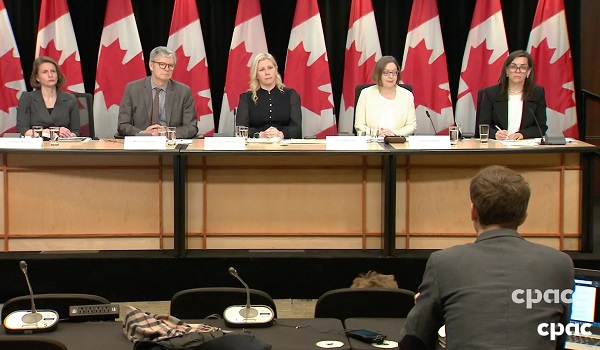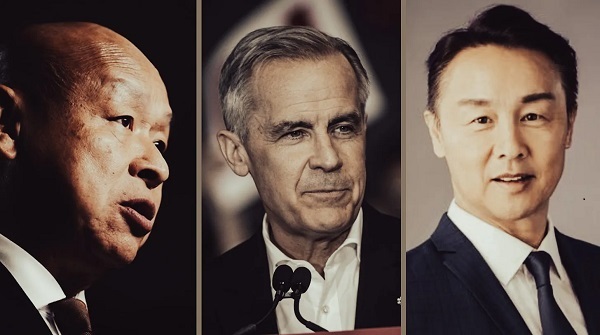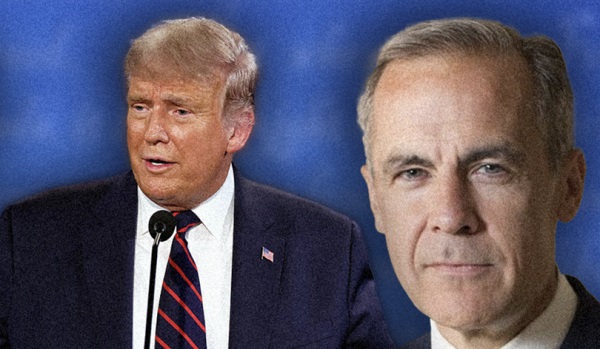Business
Carbon tariff proposal carries risks and consequences for Canada

A carbon tariff—a policy that would impose fees on imported goods based on their carbon emissions—is built on the idea that Canada should penalize foreign producers for not adhering to stringent climate policies. While this may sound like a strong stance on climate action, the reality is that such a policy carries major risks for Canada’s economy. As a resource-rich nation that exports carbon-intensive products like oil, natural gas, and minerals, Canada stands to lose more than it gains from this approach.
Mark Carney, who is competing for the federal Liberal leadership, has made the introduction of a carbon tariff the number two promise in his 16-point industrial competitiveness strategy.
Key problems with a carbon tariff in Canada
1. Retaliation from other countries
A carbon tariff (also known as a Carbon Border Adjustment Mechanism, or CBAM) would not go unchallenged by Canada’s trading partners. Major exporters to Canada, such as the United States and China, are unlikely to accept this policy without a response. They could retaliate by imposing tariffs on Canadian goods, making it significantly harder for Canadian businesses to compete in international markets. This could be particularly damaging for key industries like oil and gas, mining, and manufacturing, which rely heavily on exports. A trade war over carbon tariffs could weaken the Canadian economy and lead to job losses across multiple sectors.
2. Canada is an exporting nation
Canada exports far more carbon-intensive goods than it imports. By introducing a carbon tariff on foreign products, Canada is effectively inviting other countries to do the same, targeting Canadian exports with similar carbon-based tariffs. This would make Canadian goods more expensive on the global market, reducing demand for them and harming the very industries that drive Canada’s economy. The result? A weaker economy, job losses, and higher costs for businesses that depend on trade.
3. Big business paying for consumers’ emissions
The Carney plan also proposes to make large businesses bear the cost of helping individual households lower their carbon emissions. While this may sound like a fair approach, in practice, these costs will be passed down to consumers. Businesses will need to offset these additional expenses, leading to higher prices on everyday goods and services. In the end, it is Canadian families who will bear the financial burden, facing increased living costs, higher taxes, and fewer job opportunities as businesses struggle to absorb the additional costs.
CBAM in context: implications for Canada
Has this been tried elsewhere?
The European Union’s Carbon Border Adjustment Mechanism (CBAM) is currently in effect. It entered its transitional phase on October 1, 2023, during which importers of certain carbon-intensive goods are required to report the embedded emissions of their imports without incurring financial liabilities. This phase is set to last until the end of 2025. The definitive regime, where importers will need to purchase CBAM certificates corresponding to the carbon emissions of their imported goods, is scheduled to begin in 2026.
However, Europe is not Canada’s largest trading partner—that is the United States. With Donald Trump back in the presidency, there is no chance that the U.S. will implement a CBAM of its own. If Canada were to move forward with a unilateral carbon tariff, if anyone prepared to argue that it would not face significant economic punishment from the Trump White House?
Moreover, with 91 percent of the world having no carbon tariff, other countries would impose countermeasures, leaving Canadian businesses struggling to remain competitive.
This raises the question: is the push for a carbon tariff in Canada more about political positioning than economic pragmatism? Given the unlikelihood of U.S. participation, a Canadian CBAM would amount to a unilateral economic sacrifice. While this may appeal to certain voter bases, the reality is that such a policy would carry immense risks without global coordination. Policymakers should carefully consider whether pursuing this path makes sense in a world where Canada’s largest trading partner is unlikely to follow suit.
Where do others stand?
Chrystia Freeland, the former finance minister and current Liberal leadership candidate, has not explicitly detailed her stance on carbon tariffs. However, she has emphasized the importance of defending Canadian interests against U.S. economic nationalism, particularly in response to potential tariffs from the U.S.
Conservative leader Pierre Poilievre is a vocal critic of carbon pricing mechanisms, including carbon taxes, and has pledged to repeal such measures if elected.
Elizabeth May, leader of the Green Party, has consistently advocated for strong environmental policies, including carbon pricing, but has not specifically addressed carbon tariffs in recent statements.
What it means to consumers
Here are some relatable examples of carbon-intensive exports and imports for the average Canadian:
Carbon-Intensive Exports from Canada
Oil & Gas – Canada is a major exporter of crude oil, natural gas, and refined petroleum products, particularly to the U.S. If a carbon tariff were applied to these products, it could make them more expensive and less competitive in global markets, affecting jobs in Alberta, Saskatchewan, and Newfoundland.
Lumber & Pulp – Canada is a leading exporter of forestry products, including lumber, paper, and pulp, which require significant energy and emissions to produce. If tariffs are imposed on Canadian wood products, the forestry sector could suffer.
Agricultural Products – Fertilizers, beef, and grain production all have significant carbon footprints. If trading partners retaliate with tariffs, Canadian farmers may struggle to compete in global markets.
Carbon-Intensive Imports into Canada
Steel & Aluminum – Canada imports a large amount of steel, primarily from China and the U.S., which is essential for industries like construction, manufacturing, and automotive production. A carbon tariff would drive up costs for these industries.
Consumer Goods from China – Many everyday products (electronics, clothing, appliances) are imported from countries with high-carbon electricity grids. A carbon tariff could increase the price of these goods for Canadian consumers.
Food Products – Imported produce, meats, and packaged foods from countries like the U.S. and Mexico often have high transportation-related emissions. A carbon tariff could increase grocery bills.
Business
Saskatchewan becomes first Canadian province to fully eliminate carbon tax

From LifeSiteNews
Saskatchewan has become the first Canadian province to free itself entirely of the carbon tax.
On March 27, Saskatchewan Premier Scott Moe announced the removal of the provincial industrial carbon tax beginning April 1, boosting the province’s industry and making Saskatchewan the first carbon tax free province.
Under Moe’s direction, Saskatchewan has dropped the industrial carbon tax which he says will allow Saskatchewan to thrive under a “tariff environment.”
“I would hope that all of the parties running in the federal election would agree with those objectives and allow the provinces to regulate in this area without imposing the federal backstop,” he continued.
The removal of the tax is estimated to save Saskatchewan residents up to 18 cents a liter in gas prices.
The removal of the tax will take place on April 1, the same day the consumer carbon tax will reduce to 0 percent under Prime Minister Mark Carney’s direction. Notably, Carney did not scrap the carbon tax legislation: he just reduced its current rate to zero. This means it could come back at any time.
Furthermore, while Carney has dropped the consumer carbon tax, he has previously revealed that he wishes to implement a corporation carbon tax, the effects of which many argued would trickle down to all Canadians.
The Saskatchewan Association of Rural Municipalities (SARM) celebrated Moe’s move, noting that the carbon tax was especially difficult on farmers.
“I think the carbon tax has been in place for approximately six years now coming up in April and the cost keeps going up every year,” SARM president Bill Huber said.
“It puts our farming community and our business people in rural municipalities at a competitive disadvantage, having to pay this and compete on the world stage,” he continued.
“We’ve got a carbon tax on power — and that’s going to be gone now — and propane and natural gas and we use them more and more every year, with grain drying and different things in our farming operations,” he explained.
“I know most producers that have grain drying systems have three-phase power. If they haven’t got natural gas, they have propane to fire those dryers. And that cost goes on and on at a high level, and it’s made us more noncompetitive on a world stage,” Huber decalred.
The carbon tax is wildly unpopular and blamed for the rising cost of living throughout Canada. Currently, Canadians living in provinces under the federal carbon pricing scheme pay $80 per tonne.
Automotive
Electric cars just another poor climate policy

From the Fraser Institute
The electric car is widely seen as a symbol of a simple, clean solution to climate change. In reality, it’s inefficient, reliant on massive subsidies, and leaves behind a trail of pollution and death that is seldom acknowledged.
We are constantly reminded by climate activists and politicians that electric cars are cleaner, cheaper, and better. Canada and many other countries have promised to prohibit the sale of new gas and diesel cars within a decade. But if electric cars are really so good, why would we need to ban the alternatives?
And why has Canada needed to subsidize each electric car with a minimum $5,000 from the federal government and more from provincial governments to get them bought? Many people are not sold on the idea of an electric car because they worry about having to plan out where and when to recharge. They don’t want to wait for an uncomfortable amount of time while recharging; they don’t want to pay significantly more for the electric car and then see its used-car value decline much faster. For people not privileged to own their own house, recharging is a real challenge. Surveys show that only 15 per cent of Canadians and 11 per cent of Americans want to buy an electric car.
The main environmental selling point of an electric car is that it doesn’t pollute. It is true that its engine doesn’t produce any CO₂ while driving, but it still emits carbon in other ways. Manufacturing the car generates emissions—especially producing the battery which requires a large amount of energy, mostly achieved with coal in China. So even when an electric car is being recharged with clean power in BC, over its lifetime it will emit about one-third of an equivalent gasoline car. When recharged in Alberta, it will emit almost three-quarters.
In some parts of the world, like India, so much of the power comes from coal that electric cars end up emitting more CO₂ than gasoline cars. Across the world, on average, the International Energy Agency estimates that an electric car using the global average mix of power sources over its lifetime will emit nearly half as much CO₂ as a gasoline-driven car, saving about 22 tonnes of CO₂.
But using an electric car to cut emissions is incredibly ineffective. On America’s longest-established carbon trading system, you could buy 22 tonnes of carbon emission cuts for about $660 (US$460). Yet, Ottawa is subsidizing every electric car to the tune of $5,000 or nearly ten times as much, which increases even more if provincial subsidies are included. And since about half of those electrical vehicles would have been bought anyway, it is likely that Canada has spent nearly twenty-times too much cutting CO₂ with electric cars than it could have. To put it differently, Canada could have cut twenty-times more CO₂ for the same amount of money.
Moreover, all these estimates assume that electric cars are driven as far as gasoline cars. They are not. In the US, nine-in-ten households with an electric car actually have one, two or more non-electric cars, with most including an SUV, truck or minivan. Moreover, the electric car is usually driven less than half as much as the other vehicles, which means the CO₂ emission reduction is much smaller. Subsidized electric cars are typically a ‘second’ car for rich people to show off their environmental credentials.
Electric cars are also 320–440 kilograms heavier than equivalent gasoline cars because of their enormous batteries. This means they will wear down roads faster, and cost societies more. They will also cause more air pollution by shredding more particulates from tire and road wear along with their brakes. Now, gasoline cars also pollute through combustion, but electric cars in total pollute more, both from tire and road wear and from forcing more power stations online, often the most polluting ones. The latest meta-study shows that overall electric cars are worse on particulate air pollution. Another study found that in two-thirds of US states, electric cars cause more of the most dangerous particulate air pollution than gasoline-powered cars.
These heavy electric cars are also more dangerous when involved in accidents, because heavy cars more often kill the other party. A study in Nature shows that in total, heavier electric cars will cause so many more deaths that the toll could outweigh the total climate benefits from reduced CO₂ emissions.
Many pundits suggest electric car sales will dominate gasoline cars within a few decades, but the reality is starkly different. A 2023-estimate from the Biden Administration shows that even in 2050, more than two-thirds of all cars globally will still be powered by gas or diesel.
Source: US Energy Information Administration, reference scenario, October 2023
Fossil fuel cars, vast majority is gasoline, also some diesel, all light duty vehicles, the remaining % is mostly LPG.
Electric vehicles will only take over when innovation has made them better and cheaper for real. For now, electric cars run not mostly on electricity but on bad policy and subsidies, costing hundreds of billions of dollars, blocking consumers from choosing the cars they want, and achieving virtually nothing for climate change.
-

 2025 Federal Election2 days ago
2025 Federal Election2 days agoFixing Canada’s immigration system should be next government’s top priority
-

 2025 Federal Election2 days ago
2025 Federal Election2 days agoChina Election Interference – Parties Received Security Briefing Days Ago as SITE Monitors Threats to Conservative Candidate Joe Tay
-

 2025 Federal Election2 days ago
2025 Federal Election2 days agoLondon-Based Human Rights Group Urges RCMP to Investigate Liberal MP for Possible Counselling of Kidnapping
-

 2025 Federal Election2 days ago
2025 Federal Election2 days agoJoe Tay Says He Contacted RCMP for Protection, Demands Carney Fire MP Over “Bounty” Remark
-

 2025 Federal Election2 days ago
2025 Federal Election2 days agoHong Kong-Canadian Groups Demand PM Carney Drop Liberal Candidate Over “Bounty” Remark Supporting CCP Repression
-

 2025 Federal Election2 days ago
2025 Federal Election2 days agoBeijing’s Echo Chamber in Parliament: Part 2 – Still No Action from Carney
-

 2025 Federal Election1 day ago
2025 Federal Election1 day agoRCMP Confirms It Is ‘Looking Into’ Alleged Foreign Threat Following Liberal Candidate Paul Chiang Comments
-

 International11 hours ago
International11 hours agoTrump’s ‘Golden Dome’ defense shield must be built now, Lt. Gen. warns








